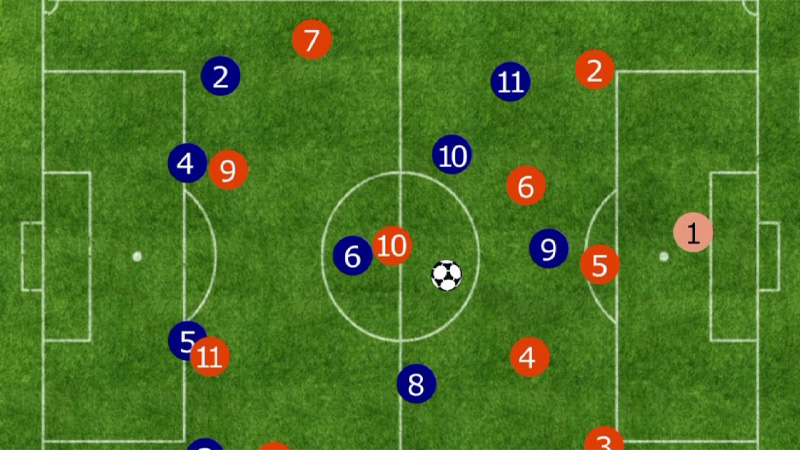In the intricate world of soccer, formations hold the key to unlocking a team’s true potential on the field. These strategic configurations determine how players position themselves, impacting every aspect of the game, from defensive solidity to attacking flair.
Delving into the realm of soccer formations is vital for coaches seeking to optimize their team’s performance, players striving to excel in their designated roles, and fans eager to understand the tactical intricacies that underpin the sport.
This comprehensive guide aims to unravel the mystery behind various soccer formations, examining their unique characteristics and the ways they influence team dynamics.
What Are Formations in Soccer?
In soccer, formations refer to the strategic arrangements of players on the field during a match. They dictate the positions and roles of players and influence team tactics. Common formations are denoted by numbers, such as 4-4-2 or 4-3-3, representing the number of defenders, midfielders, and forwards, respectively.
Each formation has its strengths and weaknesses, impacting team dynamics, defensive solidity, and attacking options. Coaches often choose formations based on their team’s playing style, the opponent’s strengths, and the desired balance between attack and defense.
Formations play a crucial role in shaping the flow of the game and determining a team’s overall strategy.
20 Most Essential Soccer Formations List
Usually, soccer formations are strategic arrangements of players that influence team tactics, defensive structure, and attacking options. Each formation caters to a unique playing style and game plan.
1. 4-4-2 Formation
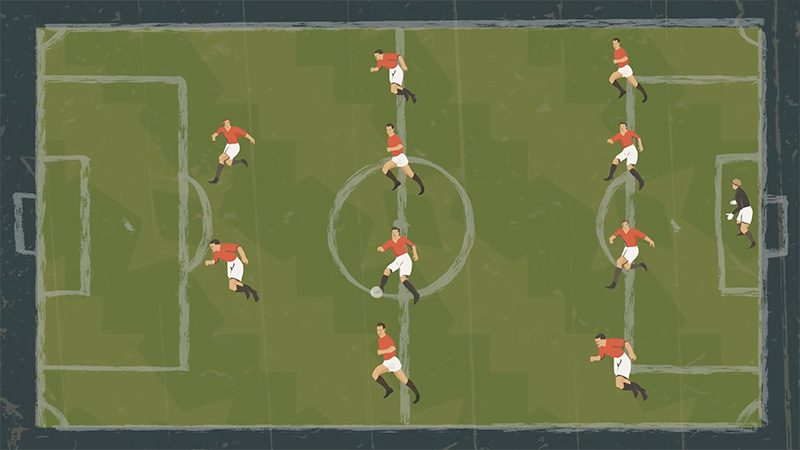
The 4-4-2 formation is a classic and widely used tactical setup in soccer. It consists of four defenders, four midfielders, and two forwards. The backline usually comprises two center-backs flanked by two full-backs.
In midfield, there are two central midfielders and two wingers. The two forwards are usually a combination of a target man and a more mobile striker. This formation provides defensive stability with two banks of four players, making it difficult for opponents to penetrate centrally.
The wide midfielders offer support both in attack and defense, while the two forwards can work together to create scoring opportunities. The 4-4-2 formation is known for its simplicity and adaptability to various playing styles.
2. 4-3-3 Formation
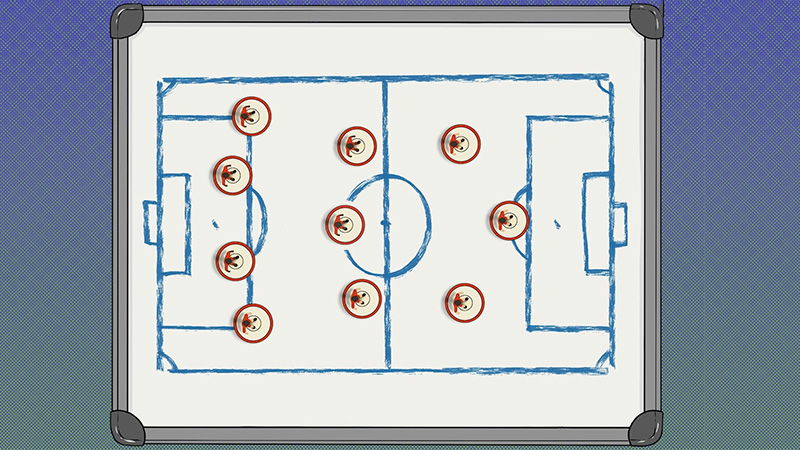
The 4-3-3 formation is an attacking-minded setup that emphasizes width and fluidity. It consists of four defenders, three central midfielders, and three forwards. The backline is similar to the 4-4-2, but in midfield, there is a single defensive midfielder supported by two box-to-box midfielders.
The front three typically consist of two wingers and a central striker. This formation enables dynamic attacking play, with the wingers cutting inside or stretching the defense-wide.
The midfield trio provides a good balance between attack and defense, and the front three can put immense pressure on the opposition’s defense. The 4-3-3 is favored by teams seeking dominance in possession and high-pressing strategies.
3. 4-2-3-1 Formation
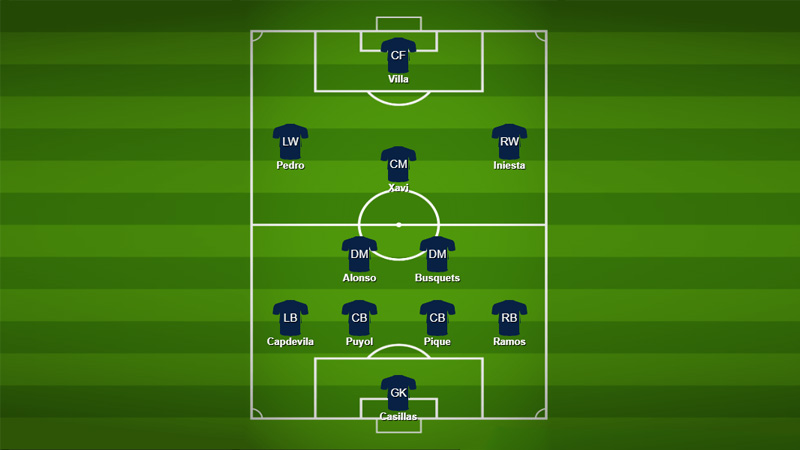
Source: jobsinfootball
The 4-2-3-1 formation is a modern variation of the traditional 4-4-2, offering a more balanced approach to both defense and attack. It features four defenders, two central defensive midfielders, three attacking midfielders, and a lone striker.
The defensive midfield duo provides a shield to the backline while facilitating smooth transitions between defense and attack. The three attacking midfielders can include a central playmaker and two wide players who can cut inside or run down the flanks.
The lone striker operates as the focal point of the attack. The 4-2-3-1 formation allows for flexible gameplay, providing options for possession-based or counter-attacking strategies.
4. 3-5-2 Formation
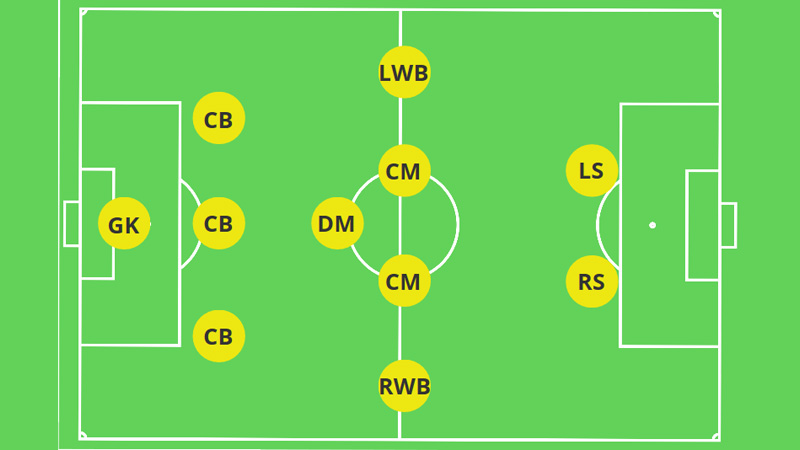
Source: themastermindsite
The 3-5-2 formation, also known as the “5-3-2” when considering defensive positioning, is a system that prioritizes numerical superiority in midfield and a solid defensive structure. It consists of three central defenders, two wing-backs who operate as both defenders and wingers, three central midfielders, and two forwards.
The wing-backs are crucial in providing width and supporting both the defense and the attack. The midfield trio controls the center of the pitch, while the two forwards work in tandem to create scoring opportunities.
The 3-5-2 is effective in congesting the midfield, preventing opponents from finding space, and it allows for quick transitions from defense to attack. It’s often used when a team wants to nullify the opposition’s midfield creativity while maintaining attacking potential.
5. 4-4-2 Formation
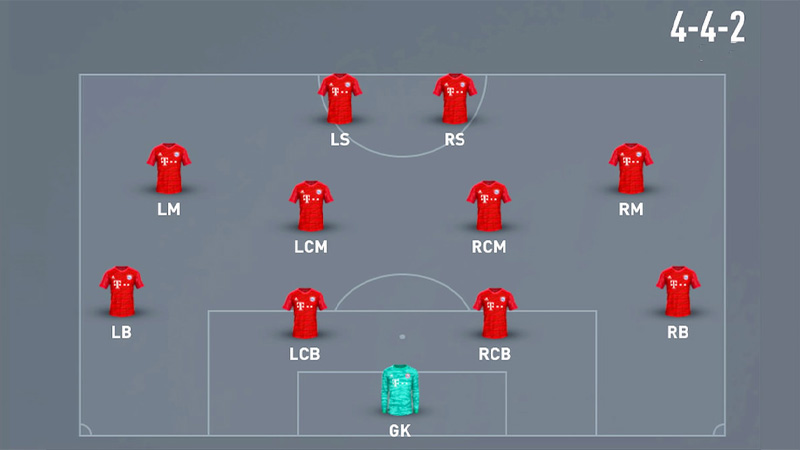
Source: fifplay
The 4-4-2 formation is a classic and widely used tactical setup in soccer. It consists of four defenders, four midfielders, and two forwards. The backline usually comprises two center-backs flanked by two full-backs.
In midfield, there are two central midfielders and two wingers. The two forwards are usually a combination of a target man and a more mobile striker. This formation provides defensive stability with two banks of four players, making it difficult for opponents to penetrate centrally.
The wide midfielders offer support both in attack and defense, while the two forwards can work together to create scoring opportunities. The 4-4-2 formation is known for its simplicity and adaptability to various playing styles.
6. 4-3-3 Formation
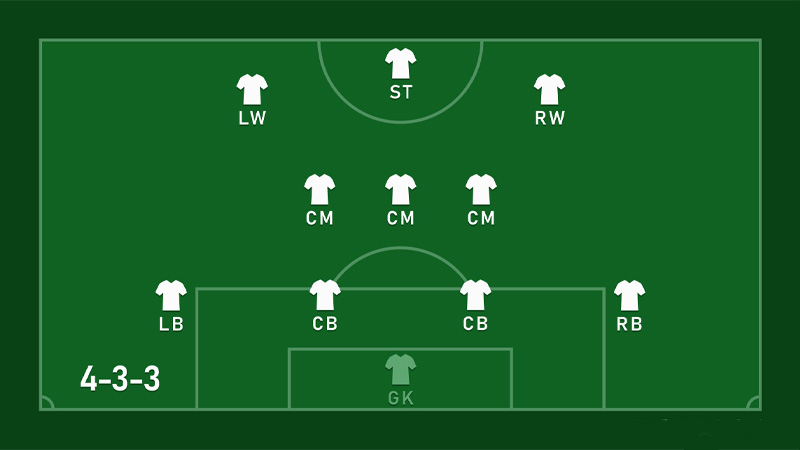
Source: footballizer
The 4-3-3 formation is an attacking-minded setup that emphasizes width and fluidity. It consists of four defenders, three central midfielders, and three forwards. The backline is similar to the 4-4-2, but in midfield, there is a single defensive midfielder supported by two box-to-box midfielders.
The front three typically consist of two wingers and a central striker. This formation enables dynamic attacking play, with the wingers cutting inside or stretching the defense-wide.
The midfield trio provides a good balance between attack and defense, and the front three can put immense pressure on the opposition’s defense. The 4-3-3 is favored by teams seeking dominance in possession and high-pressing strategies.
7. 4-2-3-1 Formation
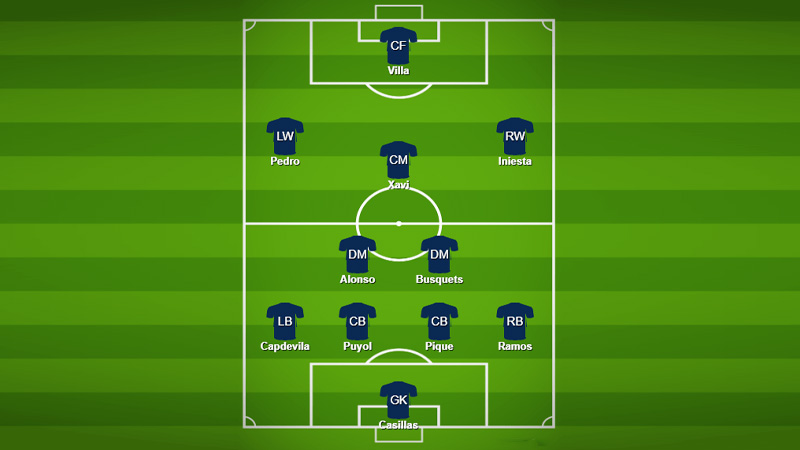
Source: jobsinfootball
The 4-2-3-1 formation is a modern variation of the traditional 4-4-2, offering a more balanced approach to both defense and attack. It features four defenders, two central defensive midfielders, three attacking midfielders, and a lone striker.
The defensive midfield duo provides a shield to the backline while facilitating smooth transitions between defense and attack. The three attacking midfielders can include a central playmaker and two wide players who can cut inside or run down the flanks.
The lone striker operates as the focal point of the attack. The 4-2-3-1 formation allows for flexible gameplay, providing options for possession-based or counter-attacking strategies.
8. 3-5-2 Formation
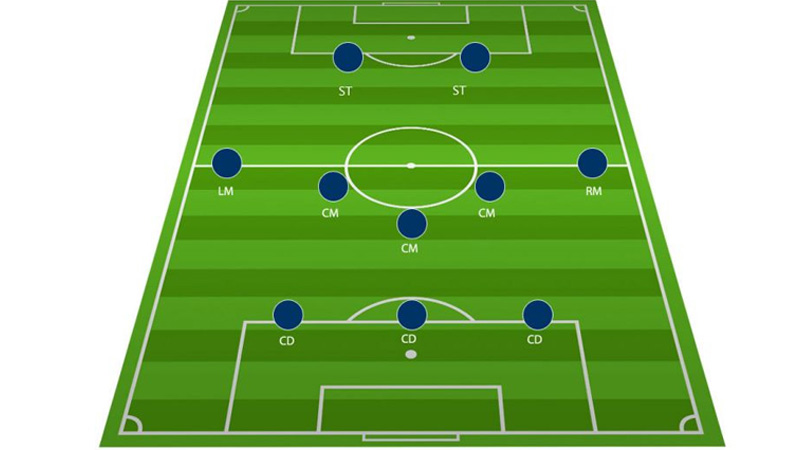
Source: theballissquare
The 3-5-2 formation, also known as the “5-3-2” when considering defensive positioning, is a system that prioritizes numerical superiority in midfield and a solid defensive structure. It consists of three central defenders, two wing-backs who operate as both defenders and wingers, three central midfielders, and two forwards.
The wing-backs are crucial in providing width and supporting both the defense and the attack. The midfield trio controls the center of the pitch, while the two forwards work in tandem to create scoring opportunities.
The 3-5-2 is effective in congesting the midfield, preventing opponents from finding space, and it allows for quick transitions from defense to attack. It’s often used when a team wants to nullify the opposition’s midfield creativity while maintaining attacking potential.
9. 4-3-2-1 Formation
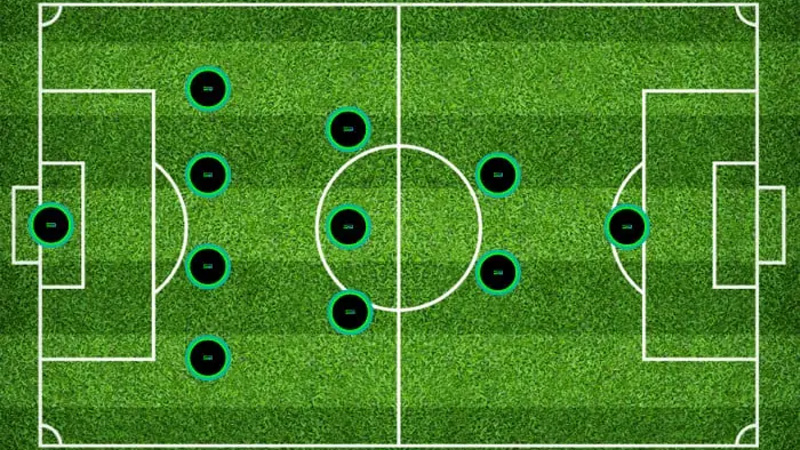
Source: soccerblade
The 4-3-2-1 formation, also known as the “Christmas Tree” formation due to its shape on the tactics board, is a variation of the traditional 4-4-2 formation. In this setup, four defenders form the backline, three midfielders occupy the central area, and two attacking midfielders or wingers play behind a lone striker upfront.
This formation emphasizes a strong central midfield presence to control the game and provides support to the lone striker. The attacking midfielders have the freedom to drift wide or make forward runs to create scoring opportunities.
It’s a flexible formation that allows teams to maintain possession and press high up the pitch, but it requires well-coordinated midfielders and disciplined defending.
10. 4-2-2-2 Formation
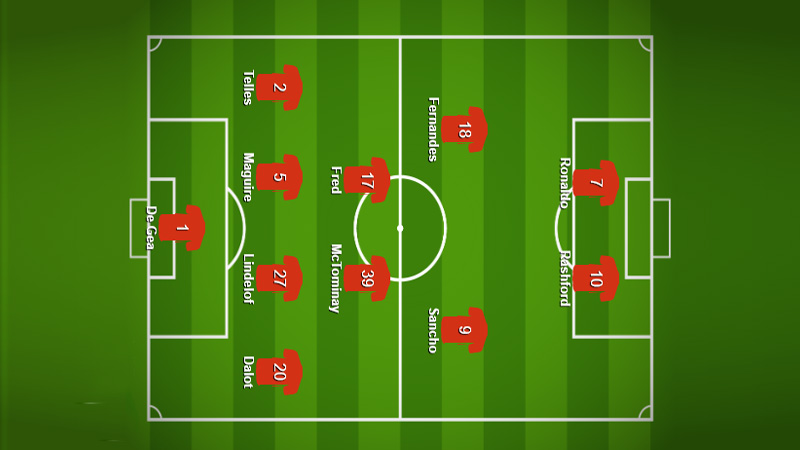
Source: jobsinfootball
The 4-2-2-2 formation is a balanced setup that focuses on controlling the central areas of the field. It consists of four defenders, two holding midfielders, two attacking midfielders, and two strikers.
The two holding midfielders provide a shield for the defense, while the attacking midfielders contribute both defensively and offensively. The two strikers offer a partnership in attack, making it challenging for opposition defenders to mark them effectively.
This formation allows for quick transitions from defense to attack and is suitable for teams with creative attacking midfielders and mobile forwards.
11. 4-3-1-2 Formation
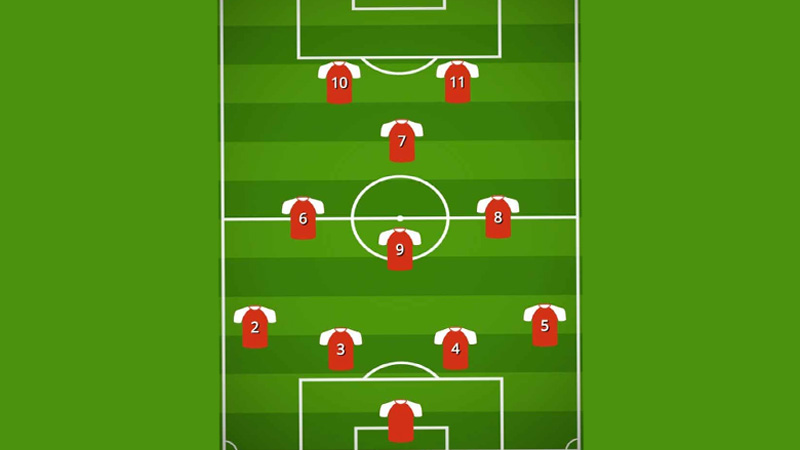
Source: soccerprime
The 4-3-1-2 formation is a narrow setup that aims to dominate the central areas of the pitch. It comprises four defenders, a central defensive midfielder, two box-to-box midfielders, and an attacking midfielder positioned just behind two strikers.
This formation enables a strong midfield presence, providing passing options and compactness in defense. The attacking midfielder serves as the link between the midfield and the strikers, often acting as a playmaker or a second forward.
It requires disciplined defending from the midfielders and coordination among the front three to create goal-scoring opportunities.
12. 4-2-4 Formation
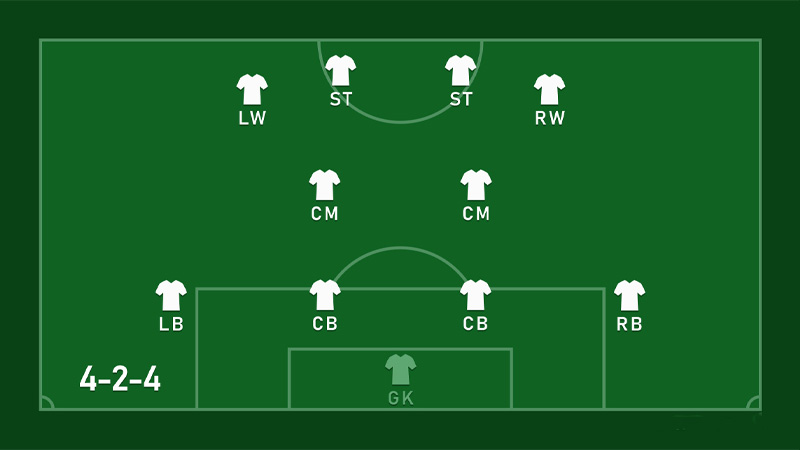
Source: footballizer
The 4-2-4 formation is an attacking-minded setup that prioritizes offensive firepower. It consists of four defenders, two central midfielders, and four forwards – two wide wingers and two central strikers.
This formation is designed to overwhelm the opposition’s defense with constant attacking threats. The wide wingers stretch the field and deliver crosses, while the central strikers work together to break down the defense.
However, the 4-2-4 formation can leave the team vulnerable in midfield, and it demands a high level of fitness and understanding among the attacking players to maintain defensive balance and swift transitions.
13. 3-6-1 Formation
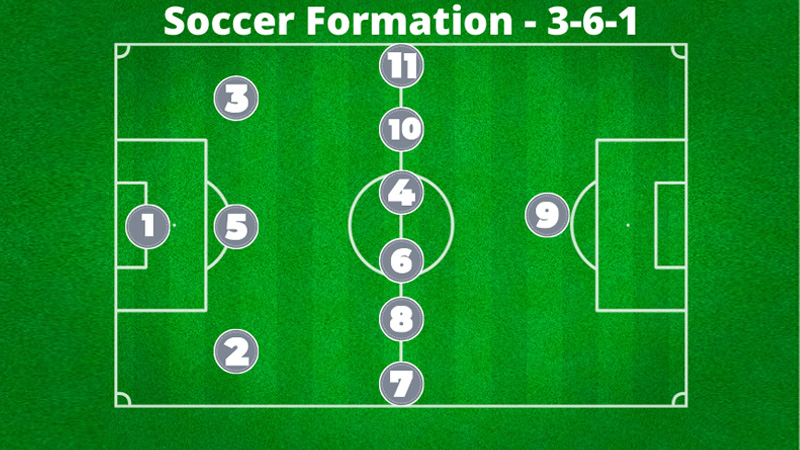
Source: yoursoccerhome
The 3-6-1 formation, also known as the 3-4-3, is an attacking-minded setup that prioritizes ball possession and creativity. It comprises three central defenders at the back, providing defensive stability and cover.
The midfield is structured with a double pivot of two central midfielders and two wide midfielders, offering both defensive cover and support in building attacks. The two attacking midfielders roam between the lines, providing creative playmaking and supporting the lone striker upfront.
This formation encourages quick ball circulation, combination plays, and overlapping runs from both the wide midfielders and the wing-backs. It requires players with strong passing abilities and tactical awareness to maintain a balanced approach between defense and attack.
14. 3-4-2-1 Formation
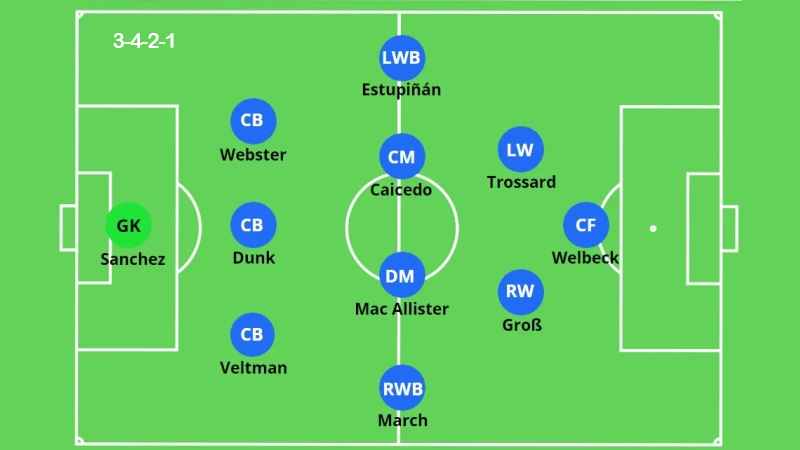
Source: themastermindsite
The 3-4-2-1 formation, often referred to as the “Christmas Tree” due to its shape, emphasizes a compact midfield and defensive unit while providing attacking support. The three central defenders form a solid defensive base, flanked by two wing-backs who contribute both offensively and defensively.
The midfield consists of two central midfielders and two attacking midfielders, forming a diamond shape. The attacking midfielders have the freedom to drift wide or operate centrally, connecting the midfield to the lone striker.
This formation aims to dominate the central areas, create numerical superiority in midfield, and exploit spaces between the lines through quick passing and intricate movements. It suits teams with technically skilled players and a focus on ball retention.
15. 4-1-3-2 Formation
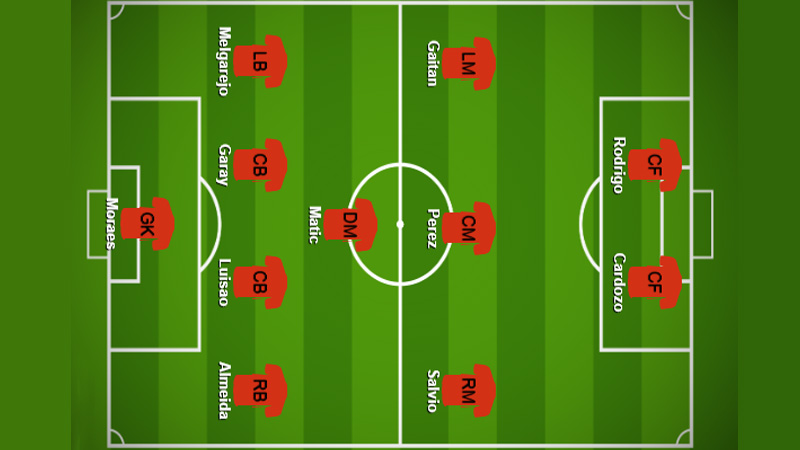
jobsinfootball
The 4-1-3-2 formation, also known as the “flat back four,” is a balanced setup that provides solidity in defense while maintaining attacking options. The backline consists of four defenders, with one holding midfielder acting as a shield in front of the defense.
The midfield is organized in a flat three, comprising two wide midfielders and a central attacking midfielder, who support the two strikers upfront. This formation encourages fluidity in attack, with the wide midfielders providing width and delivering crosses, while the central attacking midfielder creates goal-scoring opportunities.
The holding midfielder ensures defensive stability and facilitates the transition from defense to attack. The 4-1-3-2 is suitable for teams with strong defensive discipline and a focus on quick counter-attacks.
16. 3-2-3-2 Formation
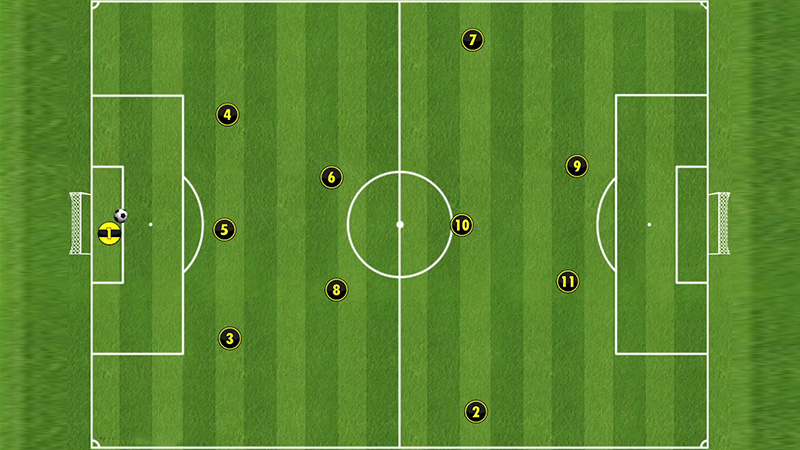
The 3-2-3-2 formation is a dynamic and aggressive setup that offers a balance between defense and attack. It includes three central defenders at the back, flanked by two defensive midfielders who shield the defense and aid in ball distribution.
The three midfielders form an inverted triangle, with a central attacking midfielder and two wide midfielders. These wide midfielders often act as wing-backs, contributing both defensively and offensively. The two forwards, usually in a strike partnership, work in tandem to create scoring opportunities and stretch the opponent’s defense.
This formation aims to dominate the midfield, exploit spaces out wide, and use quick vertical passes to break through the opposition. Teams with versatile players capable of fulfilling defensive and attacking roles thrive in the 3-2-3-2 formation.
17. 5-4-1 Formation
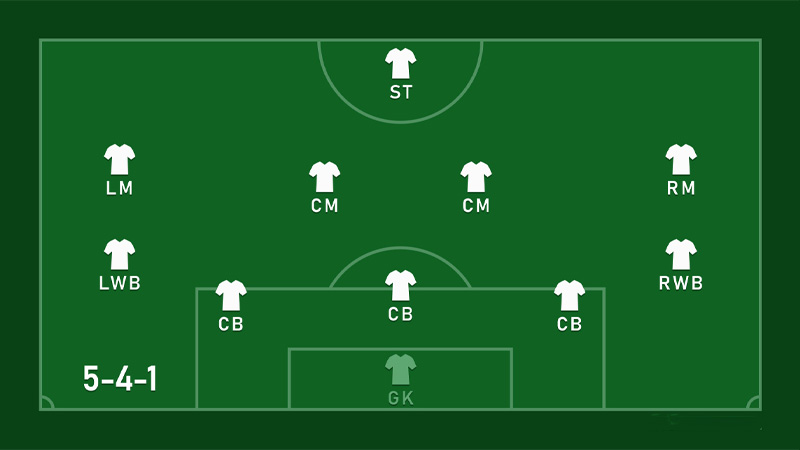
Source: footballizer
The 5-4-1 formation is a defensive-minded setup that prioritizes a strong defensive shape and compactness. It consists of five defenders (three central defenders and two full-backs), four midfielders (two central midfielders and two wide midfielders), and one lone striker upfront.
This formation is often employed by teams that aim to defend deep and frustrate opponents, relying on quick counter-attacks to create scoring opportunities.
The two wide midfielders are essential for both defensive coverage and supporting the striker during offensive transitions. The lone striker must be adept at holding up play and creating chances in isolation.
18. 3-3-3-1 Formation
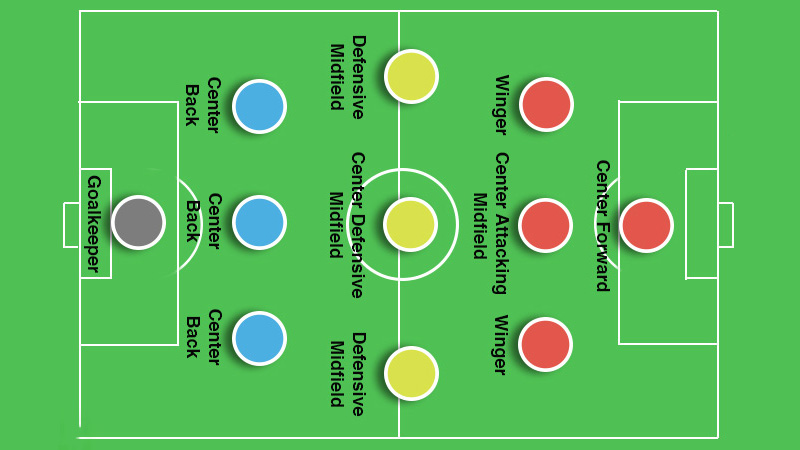
Source: storiespreschool
The 3-3-3-1 formation is an unconventional and dynamic setup that provides both defensive stability and attacking options. It consists of three central defenders, three central midfielders, three attacking midfielders (wingers and an attacking midfielder), and one central striker.
The three central defenders form a solid defensive line, while the three central midfielders help control the game’s tempo. The attacking trio provides width and creative freedom to break down opposition defenses.
The lone striker spearheads the attack and often acts as a target man to receive passes and hold the ball, allowing the attacking midfielders to join in the offensive play.
19. 5-2-2-1 Formation
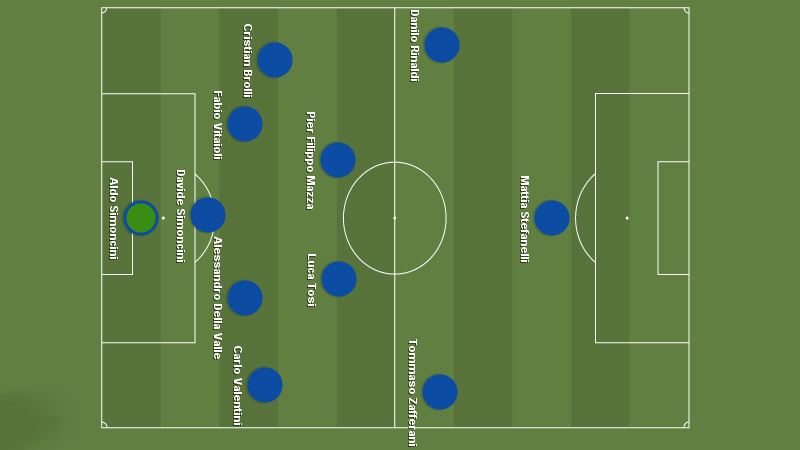
Source: pinterest
The 5-2-2-1 formation is a flexible setup that balances defensive solidity with midfield control and offensive threat. It comprises five defenders (three central defenders and two wing-backs), two central midfielders, two attacking midfielders, and one central striker.
The three central defenders offer a solid defensive foundation, while the wing-backs provide width and support in both defense and attack.
The two central midfielders act as a pivot, linking defense and attack and providing stability in the center of the pitch. The attacking midfield duo assists the lone striker, combining creativity and goal-scoring ability to create chances.
20. 4-3-2-1 Formation
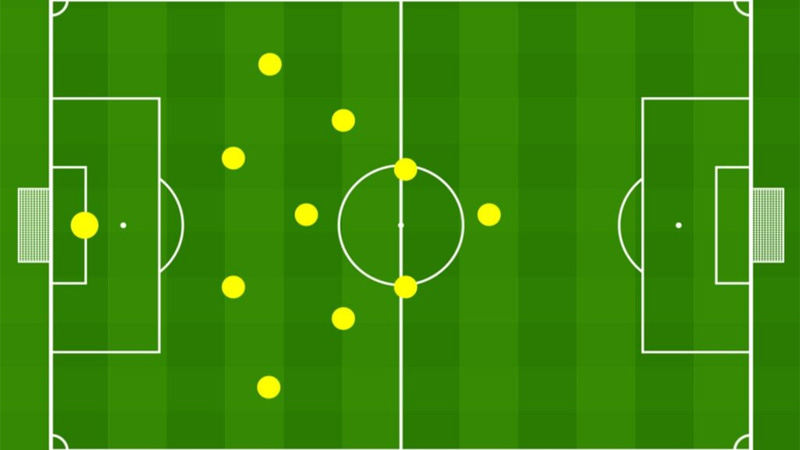
Source: fieldinsider
The 4-3-2-1 formation, also known as the “Christmas Tree” formation, is a balanced setup that emphasizes midfield control and creative play. It consists of four defenders (two center-backs and two full-backs), three central midfielders (one defensive midfielder and two central midfielders), and two attacking midfielders behind one central striker.
The defensive midfielder shields the backline, allowing the central midfielders to focus on distributing the ball and supporting attacks.
The two attacking midfielders are crucial playmakers, responsible for creating goal-scoring opportunities for the lone striker. This formation is effective for teams that prioritize ball retention and intricate passing movements in the middle of the park.
Each of these formations comes with its unique strengths and tactical nuances, catering to different team philosophies and playing styles. Coaches choose formations based on their squad’s strengths, the opponent they are facing, and the overall game plan they want to execute.
FAQs
What are soccer formations, and why are they important?
Soccer formations refer to the arrangement of players on the field, denoted by numbers such as 4-4-2 or 3-5-2. They serve as the foundation for a team’s tactics, helping players understand their roles, creating defensive structures, and organizing attacking patterns. Choosing the right formation is crucial in maximizing a team’s strengths and exploiting the opposition’s weaknesses.
How do coaches decide which formation to use?
Coaches consider several factors when choosing a formation. They analyze their team’s playing style, strengths, and weaknesses. They also take into account the opponent’s tactics and personnel. Formations can be adjusted based on match situations and the need for attacking or defensive emphasis.
What are some popular soccer formations and their characteristics?
Common formations include 4-4-2, 4-3-3, 3-5-2, and 4-2-3-1. Each has distinct characteristics, that impact the team’s approach. For example, 4-4-2 offers balance, 4-3-3 provides attacking width, 3-5-2 emphasizes midfield control, and 4-2-3-1 focuses on creativity and support for the striker.
How do formations impact player roles?
Formations determine player positions and roles. For instance, in a 4-4-2 formation, there are two central midfielders responsible for linking defense and attack, while in a 3-5-2, wing-backs are vital for width in both offense and defense. Players must adapt their playing style to fit their assigned roles within the formation.
Can formations change during a match?
Yes, formations can be adjusted during a match based on evolving circumstances. Coaches may switch formations to counter the opponent’s tactics, chase a goal, or protect a lead. Such changes can reshape the flow of the game and provide tactical advantages.
Bottom Line
Soccer formations are the blueprints that determine how a team operates on the pitch. Coaches carefully select the formation that aligns with their vision and team’s capabilities.
By understanding the strengths and weaknesses of various formations, players can execute their roles effectively and adapt to different tactical scenarios. While formations provide structure, it is the players’ skill, teamwork, and adaptability that ultimately make the difference in the beautiful game of soccer.
As the sport evolves, new formations may emerge, but the fundamental principle of finding the right balance between defense, midfield, and attack will always remain at the heart of soccer strategy.
Whether you’re a coach, player, or an enthusiastic fan, grasping the nuances of soccer formations enriches your appreciation and enjoyment of the game. Have a nice day.

